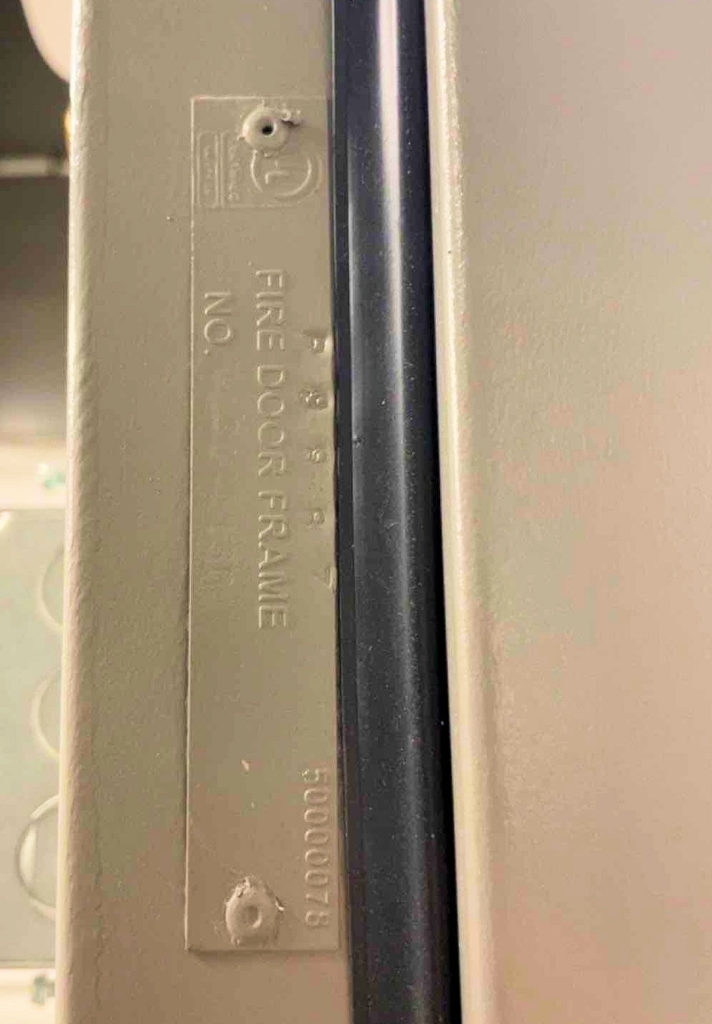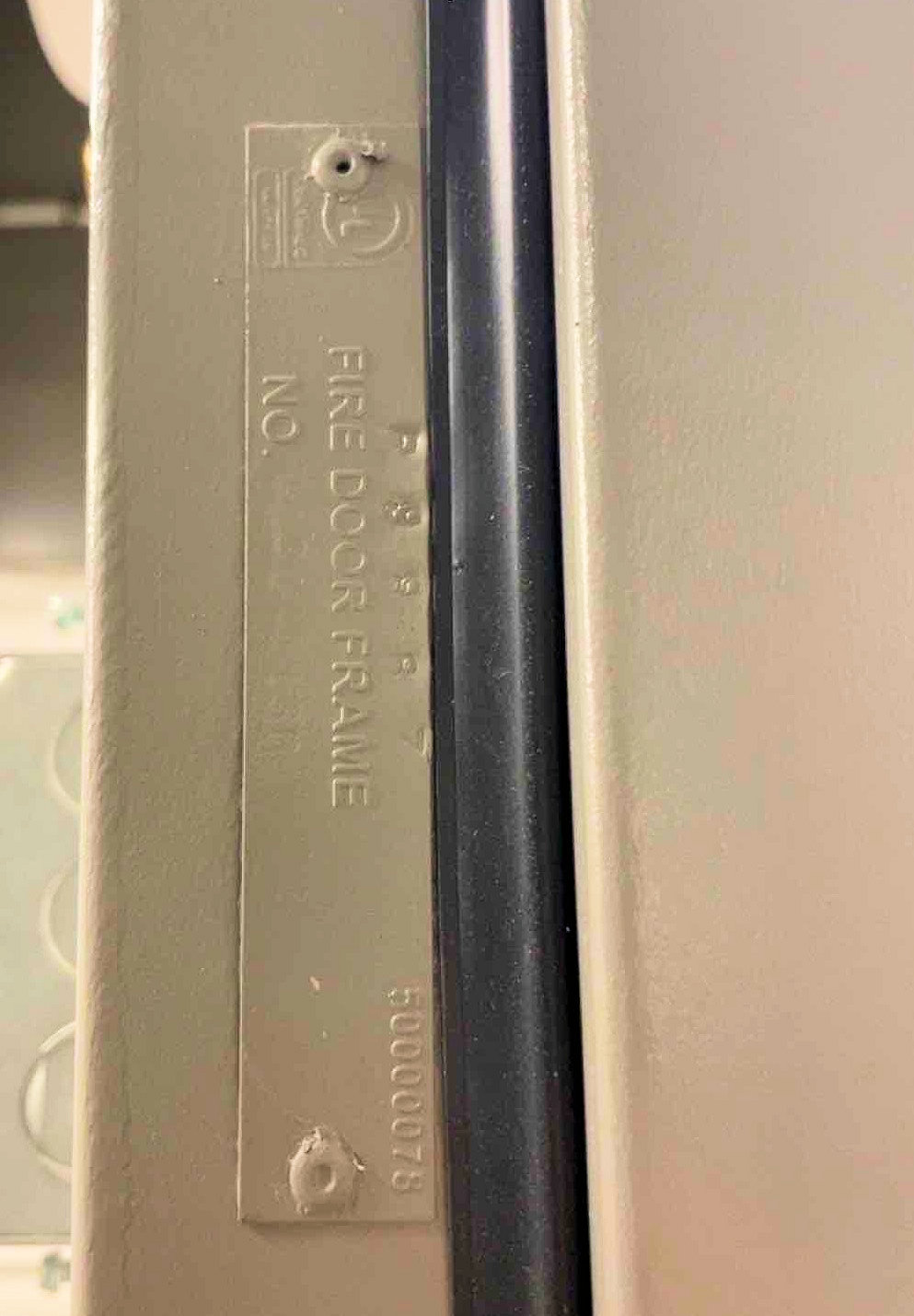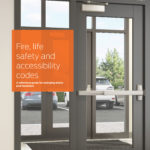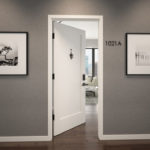 I will share my thoughts on this question in a (near) future post, but I would love to collect some insight from readers without influencing it with my comments.
I will share my thoughts on this question in a (near) future post, but I would love to collect some insight from readers without influencing it with my comments.
Unless specifically exempt from the labeling requirements, each component of a fire door assembly must be labeled to show that it is acceptable for that purpose. NFPA 80 does include some exceptions – for example, a protection plate installed on a fire door is not required to be labeled if the top of the plate is not more than 16 inches above the bottom of the door.
There are various types of labels that are permitted for these components, included the doors and frames. In Annex A, NFPA 80 states:
Labels can be permitted to be of metal, paper, or plastics or can be permitted to be stamped or diecast into the item. Labels should not be removed, defaced, or made illegible while the door is in service. If the label on an existing fire door has
been removed or is no longer legible, it is acceptable to verify the rating of the fire door through other means acceptable to the AHJ such as an inspection or certification service that provides acceptable documentation.
The inspection requirements of NFPA 80 require labels to be clearly visible and legible. So my questions for you are:
- Is the label shown in this photo legible?
- Or should the painted label be noted as a deficiency during a fire door inspection?
- What requirements of a code or standard would you point to in order to support your answer?
WWYD?
You need to login or register to bookmark/favorite this content.









As an architect, we always flag these painted-over-labels as a deficiency. It blows my mind that painters still paint over them…
It seems like they would know by now, right? Does your specification state that labels must not be painted?
– Lori
We don’t have anything in our painting spec to say not to paint labels, though that might be a good idea. To tell you truth, we’ve not had any issue w/ painters understanding & removing the paint and managing keeping the labels in good condition. A saving grace in our projects is that in our paint spec, we request a mock-up of paint application on a door/frame, and in our review of those mock-ups we’re able to formally comment, “On fire-rated doors, do not paint over label…” so, then it’s formally captured, and can’t say we didn’t tell them. 😉
The mock-up sounds like a great idea!
– Lori
Hi Lori.
If the label is still legible and includes all of the required information, then it should be acceptable. Below is the backup documentation I would use.
SDI 118 BASIC FIRE DOOR, FIRE DOOR FRAME, TRANSOM/SIDELIGHT FRAME, AND WINDOW FRAME REQUREMNTS has the following statement under section 11 Product labeling: “Embossed metal labels and embossments directly applied to doors and frames may be painted as long as the listing agency mark and all listing information is legible.”
UL’s Q&A website also mentions painted labels. Below is the portion of their statement addressing it, which I grabbed from here: https://www.ul.com/news/qa-fire-door-frames-label-considerations
“The embossment of the information on the label must be bold enough that it will be easily visible once painted. UL permits and encourages painting of embossed labels so they will not corrode and become illegible once the frames are installed. The painting of an embossed label will not affect the fire-protection rating of the frame or the legitimacy of the UL Label.”
Thanks Kristi! I had not thought about checking the SDI standards.
– Lori
I’ve had inspectors flag them for replacement of the frame and/or panel, replacement of the label, and other accept them as is when the embossing is legible like that one is… except for the number of the unit, which makes the embossing useless.
IMHO they should all be embossed such that paint can’t obscure anything important, and IF they get painted, they can get scrubbed/stripped should they ever become illegible.
I agree that would be a good solution.
– Lori
It probably meets U.L. requirements as found in their question and answer item found at the URL at the end of this coped quote:
“The embossment of the information on the label must be bold enough that it will be easily visible once painted. UL permits and encourages painting of embossed labels so they will not corrode and become illegible once the frames are installed. The painting of an embossed label will not affect the fire-protection rating of the frame or the legitimacy of the UL Label.
Other acceptable methods for providing the UL Label include separately applied Mylar® (decal) or metal labels that include frame type, the UL Certification Mark and a serial number or permanent issue number that is printed directly onto the label substrate. Labels that do not feature raised embossment of the label information should not be painted, as the paint will obscure the information.” https://www.ul.com/news/qa-fire-door-frames-label-considerations
Considering the 100’s of inspections I have been through, I don’t think too many AHJ’s are familiar with this but I may be wrong.
You stole my thunder, Jerry! I was planning to share this link in my second post (I still am)! 🙂
– Lori
NFPA 80 says the information required must be legible. So, the U.L answer does not contradict NFPA 80 which wants the important information “easily visible”. Embossed labels can be painted so long as the embossed information can be determined and U.L., the originator of the label is probably the best authority concerning it.
Thanks Jerry!
– Lori
In cases where the label has embossed or debossed lettering and it’s still “legible” I would think that is compliant, as long as it’s not too egregious. But I’ve often seen labels that are simply foil stickers and once paint is on them, not even a generous examination could classify them as still legible, in my view.
If that’s the *only* thing non-compliant, I might see the logic in telling the property, “Hey, so you know, you’ve gotta stop painting over these labels,” and see if information can be verified via some other records. But if a door has other problems (like broken parts, holes to be filled, appurtenances that are disallowed) and the site has to do some repairs anyway at that point… I would say it’s reasonable to instruct them “while you’re doing all that, please rub some paint thinner on this label so that it’s visible and legible again.”
Thanks for sharing your insight!
– Lori
We ran into this issue recently. When we reached out to the manufacturer we received a copy of a memo from UL that states the following:
“UL permits and encourages painting of embossed labels so
they will not corrode and become illegible once the frames are installed.”
Hope that helps.
Thanks Tom!
– Lori
Historically, in my observations, there have been three primary players in the painted label problem: painters, building owners, and door manufacturers. Painters don’t want to take the time to mask off something like a label and in most cases have never been educated not to paint labels. Building owners also commonly don’t know labels are not to be painted and even when they do, they fail to properly instruct painters. Door manufacturers are not opposed to selling you a new door because your label is unreadable and some of them, despite the price of the door, really cheap out on the quality of the label.
Also of note… Industry-wide there is no consistent size or shape of labels which has prevented something like pre-cut masking labels being readily available and inexpensive. Trying to mask labels with rounded ends is the worse. There also is no consistency with where a label is applied to a door. Most common placement is the hinge side rail and this is also the location of the most commonly painted over label. Less common is applying labels to the top rail is less common and in my experience top rail label are almost never painted.
Despite decades of language in all of the codes this problem persists which strongly indicates the codes are not the best solution to eliminating this long standing and ongoing problem. A more viable solution may be found with the testing and rating agencies that allow the labels to carry their approvals. If these agencies specified the location of the label, size, shape, material of construction, resistance to paint adhesion, etc. there could be significantly more industry-wide progress towards eliminating painted labels as a “forever problem”.
Great insight – thanks Larry!
– Lori
In healthcare, an AHJ like The Joint Commission will cite painted labels under their LS.02.01.10 standard EP 9 which has a note that says “Labels on fire door assemblies must be maintained in legible condition.”
Thanks Charlie!
– Lori